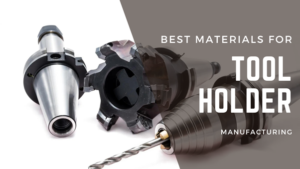Which materials are best for manufacturing tool holders in CNC?
 Tool holders are an essential component of CNC machines, as they securely hold the cutting tools in place during the machining process. The performance and longevity of a tool holder depend heavily on the material it is made of.
Tool holders are an essential component of CNC machines, as they securely hold the cutting tools in place during the machining process. The performance and longevity of a tool holder depend heavily on the material it is made of.
With a plethora of materials available, choosing the right one can be a challenge. This article will take a deep dive into the pros and cons of five popular materials used in the manufacturing of tool holders in CNC machines, including steel, carbide, aluminum, titanium, and ceramic.
Whether you’re a machinist, engineer, or manufacturing professional, this article will provide valuable insights into the best materials for your specific machining needs.
See some of our work samples from CNC!
1. Steel
Steel is a popular choice for manufacturing tool holders in CNC machines. It is strong, durable and resistant to wear, making it ideal for holding cutting tools. Steel tool holders can be further treated with heat to increase their hardness and improve their resistance to wear. According to Tool Holder Now, a popular tool holder manufacturer in China, most of their customers demand steel made holders.
Pros:
- Steel is strong and durable, making it ideal for holding cutting tools in CNC machines.
- It is widely available and relatively inexpensive compared to other materials.
- Steel tool holders can be heat-treated to increase their hardness and improve their resistance to wear.
Cons:
- Steel can rust and corrode, reducing its lifespan and effectiveness as a tool holder.
- Steel is relatively heavy compared to other materials, making it less suitable for lighter duty machining applications.
2. Carbide
Carbide is a composite material made of tungsten carbide particles bound together with a metal binder. It is an extremely hard material that is highly resistant to wear, making it ideal for holding cutting tools in CNC machines. Carbide tool holders are often used for high-speed machining and for machining materials that are difficult to cut, such as hardened steel.
Pros:
- Carbide is extremely hard and wear-resistant, making it ideal for holding cutting tools in CNC machines.
- It is suitable for high-speed machining and for machining materials that are difficult to cut, such as hardened steel.
Cons:
- Carbide is more expensive than other materials, making it less suitable for large-scale manufacturing operations.
- It is brittle, making it more prone to breakage than other materials.
3. Aluminum
Aluminum is a lightweight material that is commonly used for manufacturing tool holders in CNC machines. Machining Today, a CNC manufacturer in China also said they commonly use aluminum made products because of their market demand. It is resistant to corrosion and is easily machined, making it a popular choice for many CNC applications. Aluminum tool holders are often used for lighter duty machining operations and for applications that require a low profile tool holder.
Pros:
- Aluminum is lightweight, making it ideal for lighter duty machining applications and for applications that require a low profile tool holder.
- It is resistant to corrosion, making it a good choice for machining applications in humid or damp environments.
- Aluminum is easily machined, making it a popular choice for many CNC applications.
Cons:
- Aluminum is less durable and less wear-resistant compared to other materials, making it less suitable for heavy-duty machining applications.
- It is less rigid compared to other materials, making it less suitable for high-speed machining applications.
4. Titanium
Titanium is a strong and lightweight material that is ideal for manufacturing tool holders in CNC machines. It is resistant to corrosion and is easily machined, making it a popular choice for many CNC applications. Titanium tool holders are often used for high-speed machining and for applications that require a low-profile tool holder.
Pros:
- Titanium is strong and lightweight, making it ideal for high-speed machining and for applications that require a low-profile tool holder.
- It is resistant to corrosion, making it a good choice for machining applications in humid or damp environments.
- Titanium is easily machined, making it a popular choice for many CNC applications.
Cons:
- Titanium is more expensive than other materials, making it less suitable for large-scale manufacturing operations.
- It is less wear-resistant compared to other materials, making it less suitable for heavy-duty machining applications.
5. Ceramic
Ceramic materials are highly wearing resistant and are often used for manufacturing tool holders in CNC machines. They are ideal for high-speed machining and for machining materials that are difficult to cut, such as hardened steel. Ceramic tool holders are often used for high-performance applications, as they offer excellent stiffness and durability.
Pros:
- Ceramic materials are highly wear-resistant and ideal for high-speed machining and for machining materials that are difficult to cut, such as hardened steel.
- Ceramic tool holders offer excellent stiffness and durability, making them ideal for high-performance applications.
Cons:
- Ceramic is brittle, making it more prone to breakage compared to other materials.
- It is more expensive than other materials, making it less suitable for large-scale manufacturing operations.
Conclusion
Choosing the right material for manufacturing tool holders in CNC machines is crucial for ensuring the longevity and performance of the tooling system. Each material has its own unique strengths and weaknesses, and the best choice will depend on the specific machining application.






